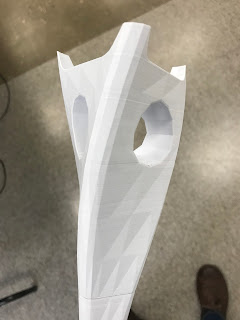After about a week of use the staff joints broke! I'm not terribly surprised. The 3D printed layers at the meeting point of pegs and staff sections were very thin and waving the staff put a lot of tension on those areas. The print layers at those parts simply separated after a time. For the next print I want to find and use some open source connectors from a site like Thingiverse. Another idea would be to run a threaded metal rod through the entire design, but this would be heavy and possibly interfere with future plans for buttons/wiring.
Wednesday, October 4, 2017
Prototype Broke!
After about a week of use the staff joints broke! I'm not terribly surprised. The 3D printed layers at the meeting point of pegs and staff sections were very thin and waving the staff put a lot of tension on those areas. The print layers at those parts simply separated after a time. For the next print I want to find and use some open source connectors from a site like Thingiverse. Another idea would be to run a threaded metal rod through the entire design, but this would be heavy and possibly interfere with future plans for buttons/wiring.
First Draft of Physical Staff



I wanted the staff's design, like the project, to be inspired by fluid motion. The first designs were based on curves and twisted geometry. My 3D modeling experience is in designing assets for games. So, designing a tool while focusing on form as well as real world function is proving to be even more challenging than I had already expected. Challenges we have discovered are:
- limited 3D print bed area requiring modular design
- the durability of these connections
- attachment point for the vive tracker
- finding the middle ground between ease/comfort of use and "cool" form
Admittedly the prototype solutions to these issues were pretty crude. Pegs and socket joints, epoxy/hot glue, and a design that proved too front heavy for comfortable long term use. But I look forward to applying these lessons to the next prop iteration.
The 3D print consisted of 4 staff sections printed on 3 Ultimaker 2 machines. The largest piece, the staff head, took about 12 hours to print. But overall the print came out virtually flawless.
Saturday, September 30, 2017
Hardware notes on Vive Tracker
Allow us to solder onto pins, and attach the tracker by clipping it on the insert.
This is a nerf gun but it has a trigger mechanism built into it
Small trigger device, that works like a game controller trigger. Springs back
We can use two pins for button presses. Action button, menu button
We can also use two pins to identify what controller is being used. Up to four controllers could be recognized with two pins.
Thursday, September 28, 2017
Project Description
Flow Form
Inside of the application the user can explore a large surreal space and create a wide variety of forms. Different effects and shapes can be generated by interacting with a 3D interface that allows the player to customize their tool.
This blog will document the process of creating the physical tools. From design ideas, to 3d printing, to the wiring and construction of controller inputs. It will also show the development of the 3d application and the revisions and changes it goes through as the project continues.
Subscribe to:
Posts (Atom)








